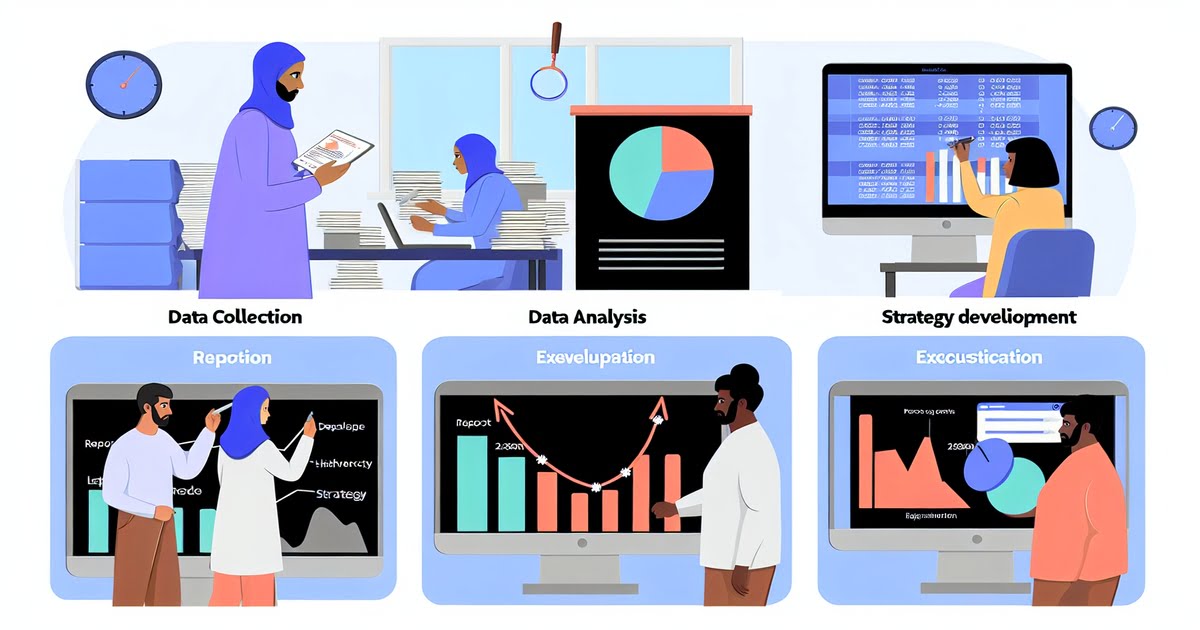Ever wondered why some pay-per-click (PPC) campaigns shoot the moon while others crash and burn? It’s all about cracking the code of analyzing PPC campaign performance. In this digital age, where every click could lead to a conversion, understanding the nuts and bolts of your campaign’s data isn’t just smart—it’s essential. We’re talking about sifting through metrics like it’s detective work, pinpointing what makes your audience tick, and tweaking those ads until they’re lean, mean converting machines. So if you’ve been scratching your head over charts and numbers or just want to amp up your game, you’re in the right spot. Let’s dive into making sense of those analytics together.
Key Takeaways
- Start with Solid Foundations: Before diving into analysis, ensure your PPC campaigns are set up with clear objectives and target audiences in mind. This initial step is crucial for meaningful analysis later on.
- Make Daily Checks a Habit: Incorporating a daily performance checklist can help identify issues early on, allowing for timely adjustments that keep your campaigns on track.
- Know Your Competition and Audience: Understanding both your audience’s behavior and your competitors’ strategies through analysis can reveal opportunities for optimization and differentiation.
- Measure What Matters: Focus on analyzing metrics that directly relate to your campaign’s success and objectives. This targeted approach ensures efforts are not wasted on irrelevant data.
- Optimize Continuously: Use insights from your analysis to refine and optimize your campaigns. This includes adjusting bids, revising ad copy, and exploring new keywords.
- Leverage Advanced Tactics: Once you’re comfortable with basic analysis, explore advanced tactics like segmentation analysis or machine learning for predictive insights, which can further enhance campaign performance.
Understanding PPC Analysis
Significance
Understanding how your PPC campaign performs is crucial. It directly affects your return on investment (ROI). By analyzing performance, you identify what works and what doesn’t. This knowledge helps improve current campaigns.
Moreover, insights from analysis guide future marketing strategies. You learn to allocate budgets more effectively. This ensures better results for each dollar spent.
Key Metrics
CTR Analysis
Click-Through Rate (CTR) measures how often people click on your ads after seeing them. A high CTR means your ads are engaging and reaching the right audience. If your CTR is low, it’s a sign that either the ad content or targeting needs optimization.
For instance, if an ad about running shoes has a high CTR, it’s probably well-targeted at runners. But if another ad promoting the same shoes gets fewer clicks, its message or design might need tweaking.
CPC Evaluation
Cost Per Click (CPC) tells us how much we pay for each click on our ads. Lower CPC means we’re getting more value out of our budget; every dollar goes further in attracting potential customers.
By tracking CPC trends over time, you can adjust bidding strategies to stay competitive without overspending. For example, if you notice a gradual increase in CPC during holidays due to competition, planning ahead with adjusted bids could maintain visibility while controlling costs.
Quality Score
Quality Score impacts where and how often your ads appear and influences their cost-per-click rates too—a higher score leads to lower costs and better ad positions.
This score depends on several factors including ad relevance to the search query, user experience on the landing page linked from the ad, and overall CTR of the campaign itself. Improving these areas boosts Quality Score which in turn enhances campaign performance.
Impression Share
Impression Share represents the percentage of times your ads were shown out of all possible instances they could have been displayed based on current keywords and settings.
A low impression share indicates that there’s room for improvement—either by increasing budget or adjusting bids—to capture a larger share of available impressions within targeted search spaces.
Setting Up PPC Campaigns
Platform Choices
Choosing the right platform for your PPC campaigns is crucial. Each platform serves a different audience and meets various objectives. For instance, Google Ads might be great for reaching a wide audience looking for specific services or products, while LinkedIn could be better for B2B marketing efforts.
Different platforms also show varied performance levels. This means some will give you more bang for your buck depending on your target market and campaign goals. By analyzing performance across platforms, marketers can pinpoint where their ads perform best. This cross-platform analysis helps in focusing efforts and budget on channels that offer the highest returns.
Budgeting Strategies
Budget plays a pivotal role in PPC campaigns. Allocating funds based on campaign performance and goals ensures resources are used efficiently. If one ad set outperforms another, shifting budget towards it can maximize ROI.
Real-time adjustments to spending can make a big difference too. Marketers who monitor their campaigns closely can respond quickly to trends or changes in performance, optimizing spend as they go along. Seasonal trends affect consumer behavior significantly. Adjusting your budget to align with these trends can capture increased demand effectively during peak times of the year.
Account Structure
A well-organized account structure makes managing PPC campaigns easier and more effective. It allows for targeted advertising by segmenting audiences based on product or service interest. This segmentation aids precise management of each group’s needs through tailored ads and landing pages. An organized structure simplifies optimization efforts too since it’s clearer what’s working well and what isn’t at both macro and micro levels of the campaign setup.
Ad Text Optimization
The text of your ads is often the first impression potential customers have of your brand online; making it clear and compelling is key to increasing click-through rates (CTR). Testing different variations helps identify which messages resonate most with your target audience. Incorporating relevant keywords into ad copy not only improves CTR but also enhances relevance scores from search engines, leading to better quality scores overall.
Daily PPC Performance Checklist
Traffic KPIs
After setting up your PPC campaigns, it’s crucial to monitor their performance closely. Traffic Key Performance Indicators (KPIs) are your first stop. They show how many visitors your site gets, where they come from, and the quality of these visits.
The beauty of tracking traffic KPIs lies in its simplicity. You quickly see which campaigns or channels bring the most visitors. This helps you decide where to put more money or effort. For example, if Google Ads drives tons of high-quality traffic compared to Facebook ads, you might shift more budget there.
But it’s not just about volume. The quality of traffic matters too. High numbers are great unless those visitors bounce off your page like a rubber ball on concrete. So, look for trends in bounce rates and session duration alongside raw visitor counts.
Conversion Tracking
Conversion tracking is next on our checklist and perhaps even more critical than monitoring traffic KPIs alone.
This step goes beyond counting clicks to understand what actions users take after landing on your site from a PPC ad—be it making a purchase, signing up for a newsletter, or downloading an eBook.
By setting up conversion tracking correctly:
- You can calculate ROI with precision.
- Make informed decisions about optimizing campaigns.
Imagine running two different ads: one leads to 10 sales while another leads only to 2 with the same investment; clearly showing which ad performs better in terms that matter most—sales!
This insight allows you to tweak underperforming ads or scale successful ones confidently.
Revenue Analysis
Finally,** revenue analysis** connects all dots between spending on PPC and actual earnings generated by these efforts.
It’s satisfying when data shows direct links between specific PPC campaigns and increased revenue streams—it means everything is working as intended! Here’s how revenue analysis benefits you:
- It pinpoints exactly which campaigns are profitable after deducting expenses.
- Guides future budget allocations based on past revenue impacts rather than mere speculation.
For instance, if Campaign A generates $5 profit per dollar spent while Campaign B breaks even at best; obviously Campaign A deserves more attention (and budget).
Audience and Competitive Analysis
Audience Analysis
Understanding who your audience is plays a crucial role in analyzing PPC campaign performance. Knowing the demographics, interests, and behaviors of your target audience can help tailor campaigns for better engagement and higher conversion rates. It’s about getting into the minds of your potential customers.
For instance, imagine you’re selling eco-friendly water bottles. Your primary audience might be environmentally conscious individuals aged 18-34. By diving deep into this group’s online behavior and preferences, you could discover they spend a lot of time on platforms like Instagram and are interested in sustainability blogs. This insight allows for more targeted ad placements.
Moreover, audience analysis isn’t just about refining current strategies; it also opens doors to new targeting opportunities or segments previously overlooked. Perhaps there’s an untapped demographic interested in zero-waste lifestyles that could align with your product offering.
Competitive Insights
On the other hand, keeping an eye on what competitors are doing is equally important. Benchmarking against competitors’ PPC strategies can provide valuable insights into market trends and keyword effectiveness.
You might notice a competitor consistently outbids you on certain keywords but ignores others that are equally relevant to your shared target market. This observation could uncover gaps in market coverage or keyword opportunities ripe for the taking.
Analyzing how rivals structure their ad copy or landing pages offers clues on how to adjust your approach to stand out or improve user experience. Maybe their call-to-action phrases are more compelling or their landing pages load faster—both factors that could influence overall campaign success.
By blending both audience understanding with competitive insights:
- Tailor ads more effectively.
- Identify underexploited market segments.
- Discover new keyword opportunities.
- Make strategic adjustments to outshine competitors.
This dual-focused approach ensures not only that you’re meeting your audience where they’re most active but also staying one step ahead of competing brands vying for their attention.
Analyzing Campaign Success
ROAS Analysis
Return on Ad Spend (ROAS) is a critical metric for gauging the profitability of PPC campaigns. It measures how much you earn for every dollar spent on advertising. A high ROAS means your advertising budget is being used efficiently, generating more revenue than it costs.
Calculating ROAS helps you understand which aspects of your campaign are working and which aren’t. If certain ads or keywords bring in a higher return, they’re worth investing more into. Conversely, low ROAS figures might indicate areas that need optimization or even discontinuation.
This analysis isn’t just about immediate gains; it informs future investment decisions too. By identifying successful strategies, you can allocate resources more effectively in upcoming campaigns. This ensures continuous improvement and growth in campaign performance over time.
Impression Analysis
Impressions count how often your ads are viewed by the target audience segments. They give you an idea of your ad’s visibility and reach within those segments.
However, high impressions don’t always mean success. For example, if you have many impressions but few clicks, there might be a problem with targeting or the ad message itself not resonating with the audience.
On the other hand, impression analysis is invaluable for brand awareness campaigns where visibility to a broad audience is key—especially when combined with other metrics like click-through rates (CTR) and engagement rates to get a fuller picture of performance.
Optimization Strategies
Wasted Spend Mitigation
Cutting down on wasted spend is crucial. It involves identifying underperforming keywords or ads. These are the ones eating into your budget without giving back any real value. By pinpointing these weak spots, you can adjust your strategy.
Adjustments might include pausing certain keywords or rewriting ad copy. This action not only reduces costs but also boosts overall campaign efficiency. Think of it as pruning a plant to encourage better growth.
A regular review cycle is essential for this process to be effective. It prevents budget wastage on elements that don’t convert visitors into customers. Imagine checking your campaign’s pulse regularly, ensuring it’s healthy and thriving by removing what doesn’t work.
Strategic Timing
Timing can make or break a PPC campaign’s success rate. Aligning ad scheduling with when your audience is most active online leads to higher engagement rates. For instance, if analytics show that your target market browses the web mostly in the evenings, then schedule more ads during those hours.
Seasonal timing takes advantage of periods with increased search interest, like holidays or major events related to your industry. Running special promotions during these times can capture more attention and conversions than usual.
Continuous testing is key here too—it helps determine the best days and times for running ads for maximum impact. You might start with assumptions based on past data but always be ready to tweak schedules based on current performance trends.
Advanced PPC Analysis Tactics
PPC Policy & Audits
PPC policies and audits are crucial for any campaign. They ensure your efforts align with platform rules. Ignoring these can lead to penalties or even bans. Regular audits spot inefficiencies or errors in your account setup.
Audits keep your account healthy. This means uninterrupted performance of your campaigns. Think of it as a regular health check-up for your PPC efforts.
By staying compliant, you avoid unnecessary roadblocks. Regular checks help maintain optimal campaign operations.
Performance Changes
Monitoring performance changes is key to adapting strategies quickly. It helps catch fluctuations in important metrics early on. This proactive approach allows for timely adjustments.
External factors often influence performance trends unexpectedly. Recognizing these influences is vital for maintaining effectiveness.
Quick response to changes keeps campaigns running smoothly. It ensures that they continue to meet their objectives without major setbacks.
Comprehensive PPC Campaign Analysis Guide
Step By Step Guide
A structured approach is key to analyzing PPC campaigns effectively. Breaking down the process into manageable tasks makes it less daunting and ensures you don’t miss anything important.
First, review your campaign goals. Are you aiming for more website visits, or are conversions your main focus? Understanding this helps tailor your analysis.
Next, dive into data collection. Look at metrics like click-through rate (CTR), cost per click (CPC), and conversion rate. Tools like Google Analytics can be very helpful here.
After gathering data, compare it against your goals. If there’s a gap, identify what might be causing it. Is it the ad copy, or maybe the targeting settings?
Finally, make adjustments based on your findings. Test new strategies in small batches to see what works best before rolling them out fully.
Practical Tips
Implementing actionable advice can lead to immediate improvements in your PPC campaigns.
One quick win is optimizing ad copy. Even small changes can significantly impact CTR and quality score.
Another tip is to refine your keyword list regularly. Remove underperforming keywords and add new ones that might perform better based on current trends.
Lastly, consider using automated bid strategies if you’re not already doing so. They can save time and optimize bids more efficiently than manual adjustments.
Post-Analysis Actions
Optimization Checklist
After diving deep into your PPC campaign analysis, it’s crucial to take targeted actions that boost performance. An optimization checklist is your best ally here. This tool ensures you cover all bases, making no aspect of optimization overlooked.
Firstly, the checklist helps in a systematic review of campaigns. It guides you through each element that could be fine-tuned for better results. For example, it might prompt you to check if your keywords are still relevant or if ad copy resonates with your target audience.
Secondly, this checklist acts as a reference for maintaining high standards across all campaigns. It reminds you to regularly update bidding strategies or test new ad formats. Consistently using an optimization checklist can transform average campaigns into high-performing ones.
Attribution Models
Choosing the right attribution model is another critical post-analysis action. These models determine how credit for conversions is distributed across various touchpoints in the customer journey.
Understanding attribution models influences how you allocate your budget towards interactions that drive conversions. For instance, if a particular channel consistently initiates customer journeys leading to sales, it deserves more investment.
Comparing different models reveals which one aligns best with specific business goals:
- Last-click attribution gives full credit to the final interaction before conversion.
- First-click attribution values the initial touchpoint that brought a user into contact with your brand.
- Linear attribution spreads credit evenly across all interactions.
Each model has its pros and cons depending on what aspect of customer behavior you wish to emphasize in evaluating campaign performance.
Final Remarks
Diving deep into PPC campaign analysis isn’t just about crunching numbers; it’s about crafting stories from data that guide your next big win. You’ve got the tools and tactics, from setting up campaigns to advanced analysis tricks. Think of it as tuning a high-performance engine—it’s all about fine-tuning until you’re ahead of the pack. Your campaigns are more than just ads; they’re your ticket to standing out in a crowded digital space.
Now, take this knowledge, run with it, and watch your campaigns soar. Remember, every click, conversion, and customer tells a story. It’s on you to listen and adapt. Ready to turn insights into action? Let’s make your PPC campaigns not just good, but legendary. Your next success story starts now. Dive in, optimize, and let the results speak for themselves.
Frequently Asked Questions
How do I start analyzing my PPC campaign performance?
Start by setting clear goals and metrics for your campaign. Then, regularly check in on key performance indicators (KPIs) like click-through rate (CTR), cost per click (CPC), conversion rate, and return on ad spend (ROAS). It’s like keeping an eye on the health of your garden – you need to know what’s thriving and what needs more attention.
What should be included in a daily PPC performance checklist?
Your daily checklist should include monitoring ad spend, checking CTRs, reviewing conversion rates, and comparing them against your targets. Think of it as giving your campaign a quick health check-up every day to ensure it’s running smoothly.
Why is audience and competitive analysis important in PPC?
Understanding both your audience and competitors gives you a strategic edge. It’s like knowing the rules of the game plus what moves your opponents are likely to make. This insight helps tailor your campaigns more effectively to stand out and resonate with potential customers.
How can I tell if my PPC campaign is successful?
Measure success by how well you meet or exceed set objectives, such as increased website traffic, higher conversion rates, or improved ROAS. Success isn’t just about big numbers; it’s about hitting those specific goals you aimed for at the start.
What are some effective optimization strategies for improving PPC campaigns?
Effective strategies include refining keywords, A/B testing ad copy and landing pages, adjusting bids based on device or time of day, and enhancing targeting settings. Imagine sculpting – start with a rough shape then refine details gradually for better results.
Can advanced PPC analysis tactics really make a difference?
Absolutely! Advanced tactics like using machine learning for bid adjustments or segmenting audiences more granely can significantly boost campaign efficiency. It’s akin to having a high-tech toolset – these sophisticated approaches can fine-tune your strategy beyond basic adjustments.
After analyzing my PPC campaign data thoroughly: now what?
Use insights gained from analysis to make informed decisions: optimize current campaigns through tweaking ads or keywords; adjust budget allocations; plan future campaigns with enhanced targeting strategies. Think of this step as plotting your next move after seeing how the board looks mid-game.









